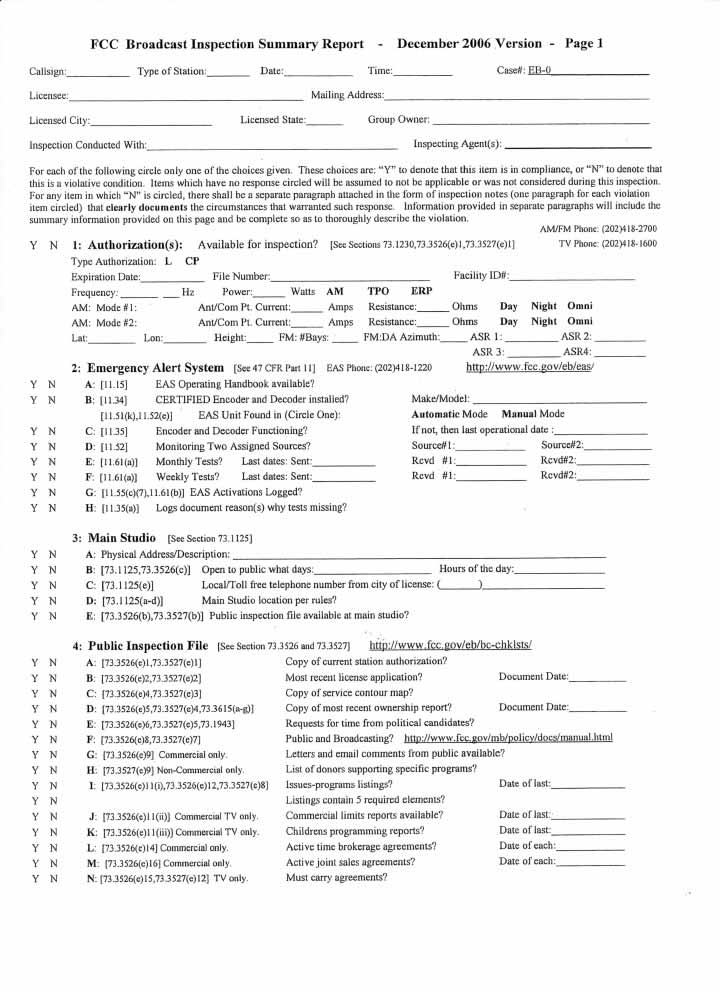So here you are, minding your own business on a not-so-frantic Wednesday afternoon when a guy shows up in the lobby and wants to see you. The receptionist says he has a badge and he is from the FCC.
Oh no! Panic! Mayhem! Chaos! Etc!
Actually, things are not as bad as they might seem, after all, this is not your father’s FCC.
Many stations use the state broadcaster associations’ Alternative Inspection Programs (AIP). This is where you pay a contractor from the broadcaster’s association to come out and do a mock inspection of your radio stations. After the station “passes” the “inspection” it is issued a “certificate” that “insures” it won’t be inspected by the FCC for three years.
Totally bogus, or as the French might say complete bull shit.
The stations I currently work for had those “certificates.” When the FCC inspector showed up, he laughed at them and inspected us anyway. We complained to the state broadcasters association and the head of the FCC enforcement bureau at the local field office, all to no avail. This happened four times. Each time the FCC inspectors found nothing and went on their way.
What did I learn from this? Why bother with the stupid AIPs when all that needs to be done is comply with the FCC’s rules. After all, the so-called “inspector” from the broadcaster’s association is merely going to use the same FCC checklist that is downloadable from the FCC website. Anyone can do that themselves.
I also learned that the FCC inspectors check a few things more closely than others. For example:
- The public inspection file should be perfect. Since they inspect these stations all the time, they know what is usually missing; Issues and quarterly reports, Contour maps, and license renewal cards.
- EAS logs and procedures. Make sure that every operator knows how to send an EAS test. Make sure that all the EAS logs have been checked and signed by the chief operator. Make sure that any discrepancies are noted.
- Directional AM station operating parameters. Still a hot-button issue and one area that trips up a lot of people. All antenna parameters are within 3 percent of licensed values. All monitor points below the maximum allowed.
- Equipment performance measurements. These are needed on all AM stations every year. They are carrier frequency harmonic measurements and NRSC-2 mask compliance measurements.
- Tower fences and tower registration numbers. Big one and easy to spot and fix. All AM towers need to have a locked fence around the base insulator. Any tower over 200 feet tall needs to be registered and have a sign with the registration number posted. The sign needs to be accessible and legible.
So prepare ahead of time for the inevitable visit. It is very easy to comply with the FCC rules using the FCC checklists. Both the AM station checklist and the FM station checklist can be downloaded and used to self-inspect any radio station.
Here is something else that I have found. Clean up the transmitter site. Sweep the floor, replace the burned-out lights, empty the garbage, keep a neat maintenance log, etc. These things go a long way to making a good first impression, which can make the inspection go a lot better.
Once, I and the FCC inspector pulled up in front of the transmitter building of an AM station. The grass in front was mowed, the bushes were all trimmed back, the field was mowed, the towers had new paint on them, The fences were in good shape, and the place just looked good. We were about to go inside when he asked “Does the inside of that place look as good as the outside?” Which it did and I said yes. Then he said he had seen enough, have a nice day.
So, when the FCC guy shows up, offer him a cup of coffee and relax, things are going to be alright.
Update: This is the actual checklist that an FCC inspector will use if he is inspecting a broadcast station.

You can download the .pdf version here.

